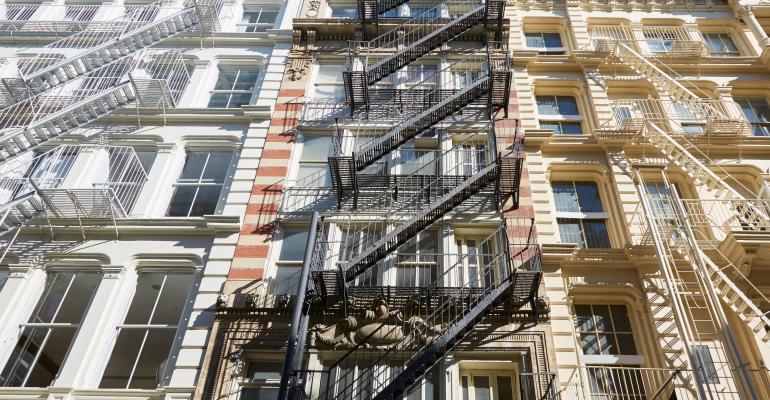The fallout from the toughened New York’s rent stabilization laws enacted 2019 is having an effect on the New York multifamily market, making it tougher for some opportunistic buyers to pursue value-add strategies that they had previously employed in the city.
“We are revaluating every aspect of our pricing,” says Shimon Shkury, president of Ariel Property Advisors. “The big incentive to invest in a unit was to raise the rents over time—that incentive is gone.”
Deals to buy and sell older apartment buildings were much less common in 2019, after the passage of the new law. Many of these older buildings are dominated by apartments covered by the rent stabilization law. However, investors continue to buy apartment properties, especially newer buildings not covered by rent stabilization. The prices investors pay overall for apartments in New York City continue to be high relative to the income produced by the properties.
Also, some value-add investors appear to be moving their money to other nearby cities not covered by rent control laws—though it’s not clear how long they may stay away from New York City.
“We are still only about eight months from the passage of the Tenant Protection Act,” says Adin Perera, market analyst with CoStar. “It will be interesting to track how many value-add deals occur in 2020 versus 2019 versus 2018.”
Investors still spent billions on NYC apartments in 2019
Investors spent $9.4 billion to buy apartment buildings in New York City over the 12 months that ended in early February, according to CoStar. That’s lower than the volume of apartment deals investors made in 2018, but still more than 2017.
Prices for apartment properties also continue to rise in 2019, according to CoStar, and have increased by about 35 percent compared with five years ago. “Cap rates have trended around 4.5 percent on average over the last several years,” says CoStar’s Perera. “They are forecasted to remain near 4.5 percent over the next five years.”
Many of the buildings now trading are newer, class-A towers created during the recent building boom in the city. For example, the biggest deals of 2019 include HUBB NYC’s $75 million acquisition of Astoria Central, a new, 99-percent-occupied apartment tower in Queens, N.Y., from Mega Contracting Group and the Treeline Companies.
However, the new rent stabilization law had a clear effect on older buildings, which are more likely to be affected by New York’s rent stabilization laws. In 2019, the amount of money investors spent to buy older apartment buildings, which CoStar calls "One Star" and "Two Star" properties, fell more than a third (35 percent) from a peak in 2015, reaching the lowest level since 2011.
An incredibly diverse range of investors buy and sell these older apartment buildings. “It’s tough to tell exactly who is steering clear and who is investing,” says Perera. “However, one notable trend over the last 12 months was that foreign investors were selling a lot more than they were buying.”
Other types investors are still buying and selling older buildings. “Long-term, patient capital has become increasingly attracted to securing multifamily opportunities at a going-in yield providing sufficient cash-on-cash returns,” according to an analysis by Ariel. “That makes the investment less dependent on the upside of rents that are no longer easily unlocked.”
Others appear to be looking outside New York City. “Investors targeting value-add opportunities in the Northeast are seeking options just outside of New York City,” says Perera. The amount of money investors spent to buy "One Star" and "Two Star" properties in the nearby metros of Northern New Jersey, Philadelphia and Stamford, Conn., were all at or near peaks in 2019, according to CoStar.
New York Re-Wrote the Book on Rent Control
Gov. Andrew Cuomo signed the Housing Stability and Tenant Protection act of 2019 on June 14, 2019.
It removes many of the most common ways property managers could substantially raise the rents or take an apartment out of rent stabilization.
“The controversial legislation will almost certainly lead to a reduction in value-add plays for assets with stabilized units in their mix,” according to an analysis by CoStar. “Landlords will now face significant hurdles in order to de-stabilize units.”
In New York City, 966,000 apartments are currently rent stabilized. That’s nearly half (45 percent) of the total rental stock, according to data from the New York Housing Conference. The number is already much smaller than it was—nearly 150,000 apartments that were once rent stabilized have left the program since 1994.
The new rent stabilization law appears to be carefully designed to make at least one kind of value-added investment impossible in the future. For many years, certain investors have bought older apartment buildings in New York City, paying high prices that would only make sense if the apartments were removed from the rent stabilization program, so that the rents could be raised much higher than the current level.
The most famous example might by Stuyvesant Town and Peter Cooper Village, a massive collection of plain, brick buildings with 11,250 apartments built just after World War II to be home to middle-class families. In 2006, Tishman Speyer Properties and the real estate arm of BlackRock paid for $5.4 billion for the properties, a price that works out to about a half-million dollars per apartment. The average rents at the complex would reportedly have to triple at the complex to justify the price, even though most of the apartments were covered by New York’s rent stabilization law. It proved to be very difficult to raise those rents, and the property was seized by its lenders in 2010.





